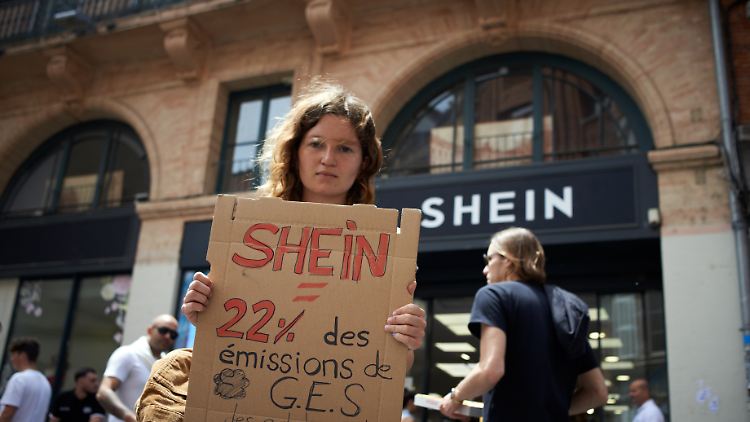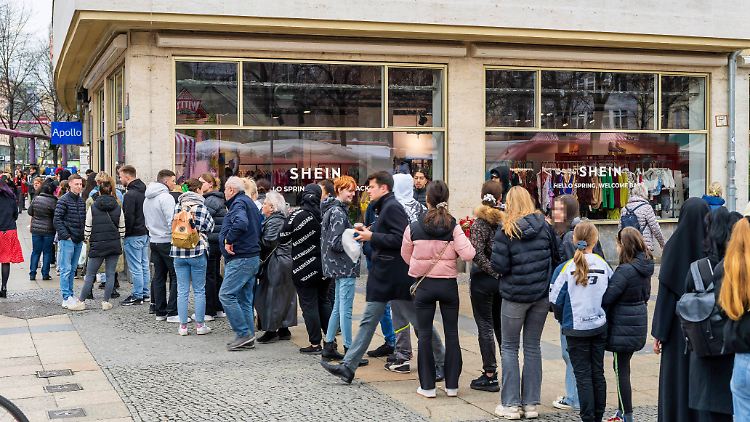Shein is one of the largest online fashion providers in the world. Fast, cheap fashion is the motto of the Chinese group. And he wants to keep growing. With India, Shein wants to open up a huge new market.
Young women dump crates by the crate, ordered clothes on the floor, proudly unpack skimpy tops, oversized trousers and tight mini skirts. Then they stagger back and forth freshly styled in front of the camera to present the new outfits to their followers on Tiktok.
There are millions of such clips on the social media platform. Entries with the Hashtag #shein sometimes viewed millions of times. Shein is one of the big players in the so-called fast fashion market. The Chinese fashion group has sales in the fast fashion sector almost 30 billion euros in 2022 in second place behind the Spanish textile group Inditex, which includes Zara, for example. Shein ranks ahead of H&M, Primark and Asos. Sales double every year.
Shein offers practically everything from clothes to cosmetics to furniture. “Influencer marketing is their most important marketing tool,” says Christiane Beyerhaus, Professor of Marketing and Trade at the International School of Management in Berlin, in the ntv podcast “Learned again”.
“The customer buys it immediately because the price is so low. And then he shows the outfit on TikTok with a hashtag from Shein. And these posts with the hashtag Shein have an incredibly high reach,” says Beyerhaus.
T-shirts for two euros
Shein is a purely digital fashion company – selling almost exclusively online, to customers overseas, primarily in the US and Europe. The Chinese group puts 3,000 new items on the platform every day. His website is the most clicked fashion site of the world. Last year, the app was downloaded around 200 million times – making Shein one of the top 20 the most downloaded apps.
Around 15,000 people visited Shein’s pop-up store on Berlin’s Tauentzienstraße at the end of March.
(Photo: IMAGO/Stefan Zeitz)
There are also temporary pop-up shops. Around 30 are planned this year in the Europe, Middle East and Africa region. One of them opened in March for a week in Berlin across from the luxury department store KaDeWe.
On the Shein website, t-shirts start at €2, dresses start at €2.50, flip-flops start at €3. Lots of cheap fabrics like polyester. It gets even cheaper with discount codes that the influencers distribute. Customers are put under pressure with limited special offers. “You have this psychological effect of triggering this need for a deficit in the customer. I have to order now, otherwise the part will be gone,” reports Beyerhaus.
Fashion from the AI pole
Rapidly, within a few days, Shein puts the clothes on the market. A test sale with small quantities can even be prepared within hours. A decision is then made as to whether a larger quantity will be produced. The fashion expert calls the business model “Real Time Fashion”. “It’s based on the fact that the fashion calendar is extremely shortened. Unlike Zara, it’s not two to three weeks from planning, from design to store, but at Shein it’s only one to two weeks.”
Shein has over 10,000 employees worldwide and is active in 150 countries, reports the “time“. There are also a lot of local suppliers. Shein doesn’t need a designer. Artificial intelligence does it automatically, evaluating which colours, fabrics, sizes and styles are going well. And sometimes designs from other brands, designers and indigenous artist simply copied. Fashion from the AI pole, so to speak.
However, the articles are produced in a completely “analogous” way in low-wage countries. Some of the seamstresses in China work 75 hours a week, without an employment contract and with only one day off a month, according to one Report of the organization Public Eye. Beyerhaus reports 18-hour working days and calls the working conditions “more than poor”.
Chemicals found in clothing

Christiane Beyerhaus heads the Global Brand & Fashion Management and Luxury Sales & Fashion Management courses at the International School of Management.
(Photo: ISM)
In addition, almost all of the clothing showed traces of chemicals, “often in very high, worrying amounts,” said the fashion professor. One shows how heavily Shein’s clothing is contaminated with chemicals Greenpeace study: Ninety-six percent of the textiles tested contained at least one hazardous chemical, including formaldehyde, heavy metals and plasticizers. These harm not only the consumers but also the workers.
Greenpeace criticizes that if these chemical substances get into the air and waste water, the environment will also be polluted. The waste balance is also questionable: fast fashion products are produced as disposable items. According to the study, less than one percent of the materials are recycled.
Recycling is often not even possible, says Elke Hortmeyer, spokeswoman for the Bremen Cotton Exchange in the ntv podcast “Learned something again”, because the fibers are often mixed these days. Jeans are mainly made of cotton, plus a percentage of elastane. “All that stuff is probably not biodegradable. And the clothes are not intended to be worn for years, but to be worn for a party at the weekend, which is absolutely catastrophic from an environmental point of view,” Hortmeyer criticizes the throw-away mentality.
Problem with long delivery times
If you order from Shein, you have to wait a comparatively long time before the things end up in the mailbox. The standard shipping time for Germany is seven to nine working days, with cheaper shipping it can even take two or three weeks. When it comes to delivery times, Shein can’t quite keep up with corporations like Amazon or German mail order companies. In Germany, Shein is located in the Ranking of the largest online fashion retailers In 2021 only in ninth place, behind Zalando, H&M and Bonprix. And is also overtaken by Amazon, the online shop with the highest turnover.
Shein has recognized the problem and therefore wants to set up more production centers worldwide in order to finally conquer the European market. “One is looking for local production sites in order to continue to support this real-time business model,” says Beyerhaus in the podcast. Production has recently started in Turkey, and Shein is also planning in Poland a 40,000 square meter warehouse. The new headquarters for Europe, the Middle East and Africa opened in Ireland in May.
Latin America is also being expanded: In Brazil, some factories are already producing for Shein, and a new factory is also to be built in Mexico. “Mexico is of course quite close to the USA, but it’s still the largest sales market and that’s why it definitely makes sense,” says Beyerhaus, assessing the plans.
Cotton from forced labour

The group Extinction Rebellion protested outside a Shein pop-up store in Toulouse in May 2022.
(Photo: picture alliance / NurPhoto)
Shein plans one too big comeback in India. In 2020, Shein was banned in India, along with dozens of other Chinese apps, including Tiktok. For this, the fast fashion giant is teaming up with the richest man in India, Mukesh Ambani. He owns Reliance Retail, the country’s largest retail chain with over 13,000 stores. Beyerhaus predicts that the low-cost fashion chain can increase its sales by a third with shops in India. The many young Indians are hungry for cheap fashion.
Through the deal, Shein also gets fabrics from Indian companies and wants to be there production center for export to the Middle East. Shein urgently needs new sources for its materials: The company is accused of using cotton from Xinjiang, a Uyghur forced labor area. It is said to have imported textiles produced with it into the USA. These are banned because of their association with Uyghur forced labour. This is another reason why Shein tries to distance himself from his home country. For about a year now, the head office has been in Singapore, rather than Guangzhou.
Shein plans to go public in the US
Shein wants to improve its image and become more sustainable. Also wants to use recycled polyester – and reduce the carbon footprint by a quarter by 2030. Less than fast fashion competitor H&M – which wants to halve its CO2 emissions by then. After all, the fashion industry with around two billion tons of CO2 according to a study responsible for around four percent of global emissions. That is as much as France, Germany and the UK together emit per year.
But that doesn’t change the huge quantities of clothing that Shein continues to produce under questionable working conditions – these quantities alone are an environmental burden.
Despite all the criticism, the Chinese company still has some plans. It wants to go public in the US. It could be one of the biggest debuts of the year.
“Learned again” is a podcast for the curious: Why would a ceasefire be just a break for Vladimir Putin? Why does NATO fear the Suwalki Gap? Why does Russia have iPhones again? What small changes in behavior can save 15 percent of energy? Listen in and get a little smarter three times a week.
All episodes can be found in the ntv app, at RTL+ music, Apple Podcasts and Spotify. “Learned something again” is also included Amazon Music and Google Podcasts accessible. For all other podcast apps, you can use the RSS feed.
